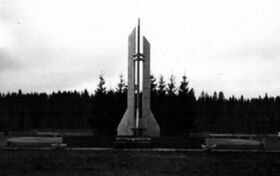Engineering:1980 Plesetsk launch pad disaster
 Memorial to victims of the disaster | |
| Date | 19:01 MSK (16:01 GMT) 18 March 1980 |
|---|---|
| Location | Plesetsk Cosmodrome Site 43 |
| Casualties | |
| 48 dead[lower-alpha 1] | |
| 87 injured (43 seriously) | |
The 1980 Plesetsk launch pad disaster was the explosion of a Vostok-2M rocket carrying a Tselina-D satellite during fueling at Site 43 of the Plesetsk Cosmodrome in Mirny at 19:01 local time (16:01 GMT) on 18 March 1980, two hours and fifteen minutes before the intended launch time. Forty-four people were killed in the initial fire and four more soon died in the hospital from burns. It is the second deadliest space exploration related disaster in history.
Sequence of events
On 17 March the rocket was installed at the launch site. Various preliminary tests conducted before the fueling went as expected and without problem. The launch of the rocket was scheduled to take place at 21:16 on 18 March. Several hours before the intended launch, the tanks were filled with kerosene at 19:00 and preceded by the addition of liquid oxygen and liquid nitrogen to side tanks. After the addition of hydrogen peroxide was completed, a huge explosion at the site was witnessed at 19:01 MSK; 44 people in the area were killed instantly and another 43 required hospitalization for burns, four of whom later died while in the hospital. Many of the survivors suffered severe burns and lung damage. Over 80% of surviving eyewitnesses to the disaster reported that the first explosion originated from Block E of the rocket and was followed by multiple secondary explosions. The 300 tons of fuel destroyed the launch pad and surrounding area.[1][2]
Aftermath
Initial investigation
The official investigation responsible for determining the cause of the disaster headed by Leonid Smirnov assigned blame to the crew that was killed at the site of the fire by specifically stating the official cause as "explosion (inflammation) of material soaked in liquid oxygen as a result of unauthorized actions of one of the members of the ground crew". However, less than a year later, on 23 July 1981 after a second disaster of the same cause was narrowly avoided, it was discovered that a design flaw in the fuel filters of the rocket were likely the cause of the 1980 disaster, although it was impossible to confirm which type of filters were used in the rocket that exploded. The catalytically active lead solder on the filters would cause an explosion upon contact with hydrogen peroxide.[1][3][4]
Cover-up
The disaster was not reported in Soviet media at the time and only reached western media outlets in 1989 upon declassification. Pravda reported that the launch of the rocket was a success and did not say anything about the explosion.[5][6][7]
Footnotes
- ↑ Initially after the events were declassified the New York Times and several other sources reported 50 deaths instead of 48; after more information about the event became available the death toll was amended to 48.
References
- ↑ 1.0 1.1 "Error: no
|title=specified when using {{Cite web}}". http://www.plesetzk.ru/index.php?p=1980&d=doc/disaster. - ↑ (in ru)РИА Новости. 2015-03-18. https://ria.ru/spravka/20150318/1053057958.html.
- ↑ Shteinberg, Alexander S. (2008-09-26) (in en). Fast Reactions in Energetic Materials: High-Temperature Decomposition of Rocket Propellants and Explosives. Springer Science & Business Media. ISBN 9783540788614. https://books.google.com/books?id=WCxkI1a4yrEC&pg=PA174.
- ↑ "Error: no
|title=specified when using {{Cite web}}". Kommersant. 2000-03-18. https://www.kommersant.ru/doc/142850. - ↑ "Soviet rocket blast left 48 dead". http://news.bbc.co.uk/2/hi/world/monitoring/media_reports/705808.stm.
- ↑ "1980 Soviet Rocket Accident Killed 50" (in en). New York Times. 28 September 1989. https://www.nytimes.com/1989/09/28/world/1980-soviet-rocket-accident-killed-50.html.
- ↑ Guardian Staff; agencies (1999-10-28). "Space disasters - a timeline" (in en). https://www.theguardian.com/science/1999/oct/28/spaceexploration.
[ ⚑ ] 62°55′43″N 40°27′24″E / 62.92861°N 40.45667°E
 |

